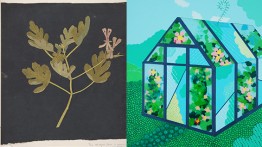An Artist’s History of Collage: Studio Course

An Artist’s History of Collage: Studio Course with Eric Hibit
Cost: $315.00
4 online sessions. THIS CLASS WILL TAKE PLACE OVER ZOOM. You will need a computer or device and we recommend that you download the latest version of the Zoom app.
Wednesdays, March 1–22, 2023
6:30 PM–9:30 PM
Before collage was “high art”, the art of gluing papers and other materials was practiced by self-taught makers. Collage has shaped major art movements of the 20th century (such as Dada, Surrealism, Pop), and a collage sensibility is evident in contemporary quilting, photography, painting, and activism (such as the AIDS Memorial Quilt). The history of collage is like a collage itself: a story made of vastly different parts, held together by their divergent nature.
In this combined art history / studio course, weekly image presentations explore specific movements and artists from the history of collage. A studio assignment based on the presentation prompts students to explore related mediums, approaches, and techniques. Demonstrations on cutting, gluing, and working with water-based paints inform student’s work and teach how to construct a collage from scratch. Methods for working with process, composition, and the basics of design provide pathways for students to define and strengthen their individual voices.
Assignments are organized sequentially to build up fundamental skills with collage. Beginning with black and white, students move onto working with a range of value, and then color. Students produce collages with found paper, painted paper, and photographic images while exploring themes of their choice. The course culminates in final projects where students define interests, hone techniques, and integrate skills. Critiques build dialogue around student’s work and foster peer learning. The course is designed for analog work with actual papers, but students are welcome to work digitally. This course is open to students at all experience levels, from no prior experience to advanced.
Supply list
14" x 11" Bristol pad
X-acto Knife
X-acto replacement blades
11" x 8.5" Cutting mat
16 oz. matte medium
Set of fluid acrylic paint
12” ruler
Pack of black construction paper
UHU glue stick
11 x 14” tracing paper
Set of flat brushes
Set of small brushes
Class #1
Collage before collage: Mary Delany, Tinsel Painting, Silhouettes / Early collage: Braque / Gris / Picasso
Assignment: Black and white collages
Create a series of collages in black and white paper. Trace household objects and cut with X-acto blades. Explore possible compositions with the cut outs, including the negative space from which the trace was cut.
Techniques and concepts: intro to cutting and gluing, positive/negative space, painting paper
Class #2
DADA and collage: Kurt Schwitters, Hannah Hoch, Raoul Hausmann, George Grosz, Otto Dix Surrealism / Pop Art: Max Ernst, Richard Hamilton, Eduardo Paolozzi
Assignment: Photomontage
The technique of photomontage results in playful - sometimes shocking - incongruence.
Cut images from found magazines, books, or prints (or work digitally) for photomontage.
Collages of the Surrealists and British Pop Artists use elements of the known world, re-contextualized in unreal ways. Richard Hamilton’s important 1956 collage “Just What Is It That Makes Today’s Home So Different, So Appealing” is both real and unreal. What is your understanding of rea/unreal?
Techniques and concepts: choosing source materials, tips for precise cutting and gluing, scale
Class #3
Impulses in Contemporary Collage: Liza Lou, Betye Saar, Bisa Butler, Rosie Lee Tompkins, Jane Quick-to-See Smith, AIDS Memorial Quilt
Final Project(s): select materials / techniques / approaches to work with independently
Choice #1: Commemoration Collage
Make a collage in response to commemoration / celebration / remembrance
Choice #2: Narrative Collage
Choose a narrative from history, fiction, or personal experience. Alternately, gather elements from a narrative and “write” it as you make the collage. The narrative does not have to be illustrated per se; it may be evoked, pointed to, reflected upon, and/or expressed in abstract terms.
Choice #3: Self-defined project
Propose a self-defined project, involving and media.
Class #4
Impulses in Contemporary Collage: Daniel Gordon, Elliott Hundley, Alison Elizabeth Taylor, Fred Tomaselli, Wangechi Mutu
Final Review of Final Projects
Group Project: Exquisite Corpse
Course Code: COL20
Instructor(s): Eric Hibit




